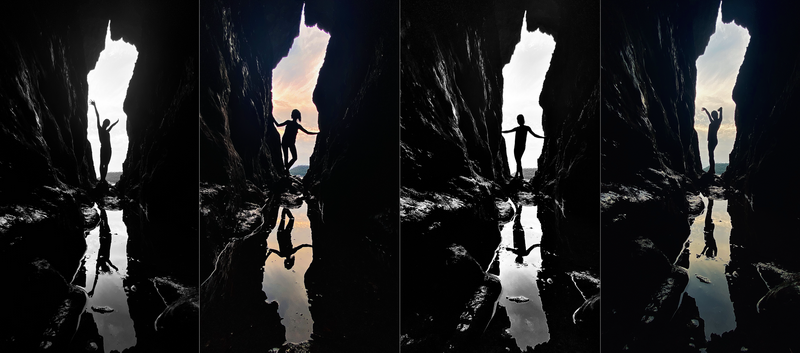Sunset Silhouettes on Imja-do
By Isaiah Winters
At the southernmost tip of Imja-do, where Korea’s West and South Seas make their murky acquaintance, is an excellent coastal cave called Yongnangul (용난굴). I’d wanted to see it for quite some time so, aroused from my mid-Chuseok torpor by a chance for adventure, I made the pleasant, bucolic drive to nearby Eomeori Beach with the missus to finally suss it out.
Crammed in between two huge Chuseok feasts, our impromptu visit was just after high tide, which is about the worst time to visit the cave, as you’re forced to swim to it rather than just saunter in at low tide. Yongnangul is located to the left of the beach around a rocky bluff, and it’s quite a walk or swim to get there from the shore. To shorten the trip, we walked along the bluff down to the lowest edge, where we found the water encouragingly placid. Just as I pushed off the rocks into the water, the missus lost her nerve and said she’d stay behind.
Knowing me and trusting in my marrow-deep stupidity, she left me to my devices and returned to her comfy beach chair and beer. Some husbands may wax suspicious when left at sea so cavalierly by their wives, but I don’t have life insurance, so I knew she wasn’t in it for the money. And so, slowly, awkwardly, and trepidatiously, I swam alone through the silty coastal waters along the rocky bluff not knowing whether I was about to swim right into a sharp, submerged rock.

Fortunately, the closer I got to the cave, the shallower the water became, and soon I was able to wade more assuredly through chest-high water toward the black, waterlogged void in the distance – at which point I promptly scraped my knee on a sharp, submerged rock, the only injury sustained on my venture. The rocks just outside the cave were worryingly slick, so I made my way over them as carefully as possible until I stepped onto the soft, brittle pebbles at the mouth of the cave.
No sooner had I arrived than scattered hundreds of various-sized sea roaches all up and down the cave walls. Warily, I had to follow them into the cave, where more and more scattered with each step I took deeper into the darkness. There were so many that some crawled over each other, slipped off the wall, and plopped down into the brackish waters covering the cave floor – incidentally, right where my feet were submerged. Unsettling as this was, I pressed on, lured ever deeper by the soft boom of waves and a faint light coming from the cave’s other end.
When I’d gotten about halfway through, I decided to stop and turn around, revealing one of the most beautiful photo opportunities I’ve ever seen. Those roach-infested waters along the cave floor turned into a brilliant mirror of light that linked at the horizon with the tall, sunlit shaft of the cave. Come sunset, the chance to take silhouette photos would be second to none, so I knew then that the missus, despite her fear of swimming in the sea and of those horrid sea roaches, would have to come back with me to model.
By the time I made my return to the shore, the tide had gone down considerably, and I was able to walk back the entire way. In that time, the wife’s beer level had also gone down quite a bit, so convincing her to come back out was easier. When we returned still later to the cave, the walk was even less challenging, which helped calm her fears of the open sea. In their effort to avoid us, the silent droves of roaches that fanned up the rocks and into every crevice ensured that at least some fear was felt, however. Nevertheless, the missus was soon on her silhouette perch with sunset hues blazing behind her.

The more photos I took, the higher I ascended to Valhalla, slain by the beauty and adventure of the moment. The missus oscillated between joy and disgust, giggling between poses and groaning whenever the roaches got too close. Unfortunately, it wasn’t until the end of the shoot that I figured out how best to get the intense backlighting to work in my favor, so this article only features my last few photos, some of which I admit I over edited. In such a short window of time, you have to learn as you go and as quickly as possible, so it is what it is. Ultimately, the results aren’t bad for a simple iPhone.
Following our little photo shoot, the missus mustered up enough resolve to follow me to the far end of the cave, where waters lapped gently toward us from the other direction. This is what truly makes Yongnangul so impressive: It’s open on both sides of the bluff, making it more of a tunnel than a mere chamber. If you were determined to traverse the entire length of it from end to end at low tide, you could, in which case you’d end up in a small, secluded cove where few ever go. From there, a sharp left turn would bring you to a still larger cave that I’m sure is even more impressive, though it’s a dead end that wouldn’t afford you the same sunset silhouettes pictured in this article.
Overall, Yongnangul is an excellent place for photography with a bit of adventure. Just be aware of the tides and when the sun sets to make the most of it. Enjoy!
The Author
Born and raised in Chino, California, Isaiah Winters is a pixel-stained wretch who loves writing about Gwangju and Honam, warts and all. He particularly likes doing unsolicited appraisals of abandoned Korean properties, a remnant of his time working as an appraiser back home. You can find much of his photography on Instagram @d.p.r.kwangju.





